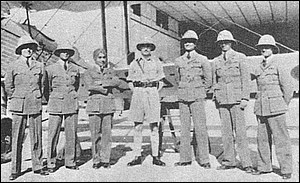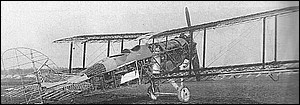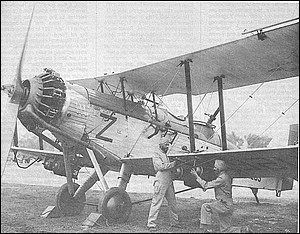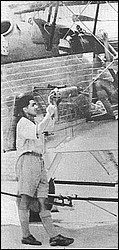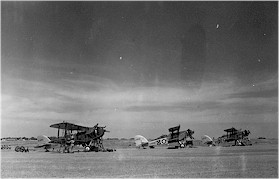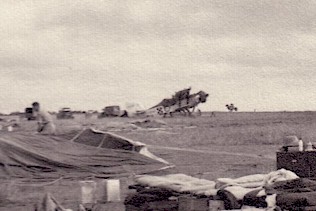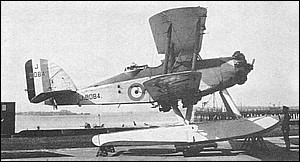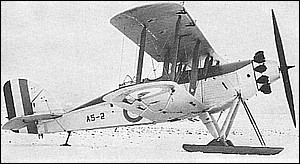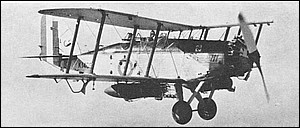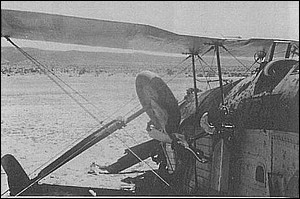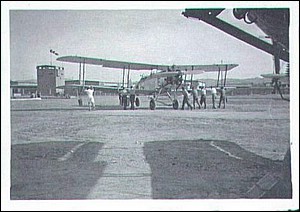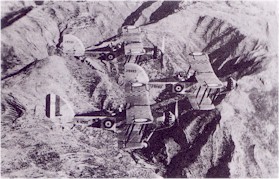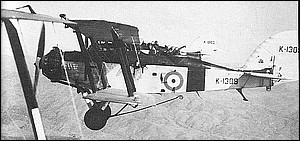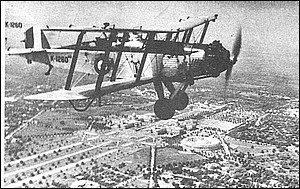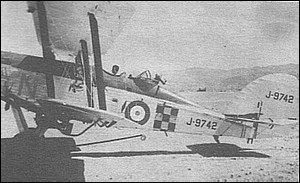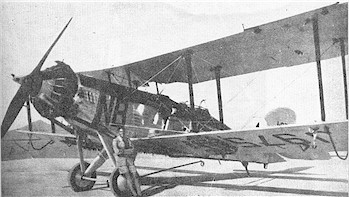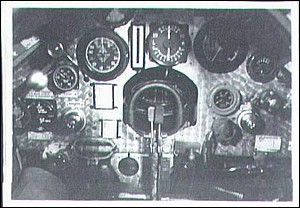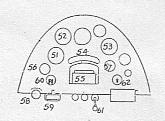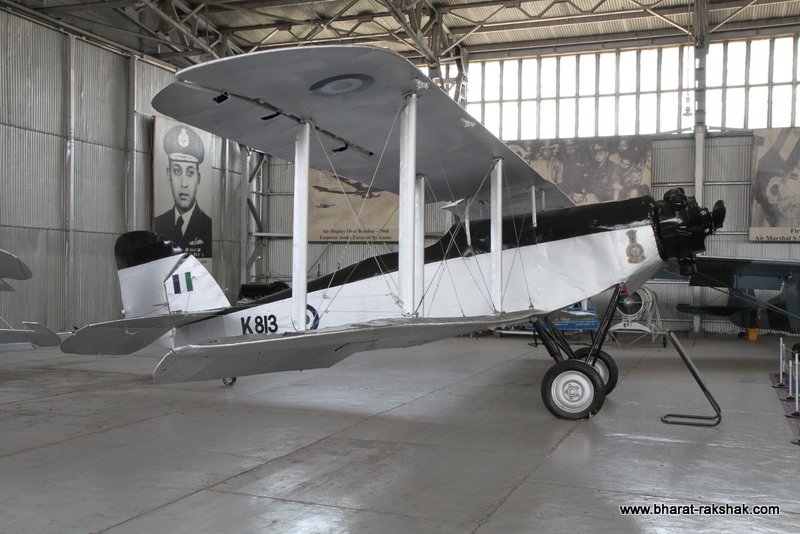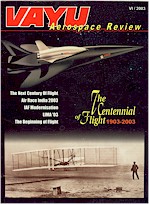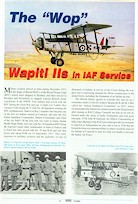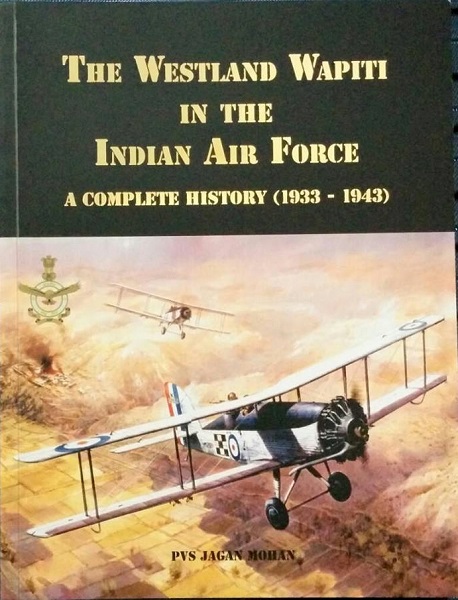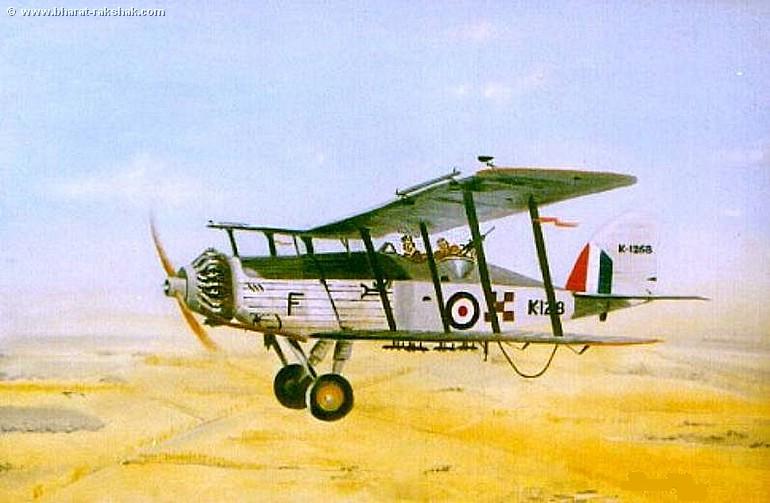
Military aviation came to India in Dec 1915, when a flight of Bristol BE2cs of the Royal Flying Corps (RFC) arrived in Bombay and moved to Risalpur and Nowshera to support various Royal Army expeditions in the NWFP. Four Indians served in the RFC during the great war and one, Lt Indra Lal ‘Laddie’ Roy claimed 9 kills flying SE 5s with 40 Squadron winning the DFC posthumously (but this was not the end of the story, for, Indra Lal Roy’s nephew later became one of the first six Indians trained at Cranwell, and later became the first Indian Squadron Commander, Station Commander and Chief of the Air Staff). Of the four only two were to return, Sardar Hardit Singh Malik, who began as an ambulance driver and finished with 28 Squadron RFC flying the Sopwith Camel (He later rose to Ambassador of India to France) and Lt Errol Sen who served with 70 sqn RAF and was shot down and taken PoW on 14 sep 1917 (later repatriated after the Armistice and leaving the service on 13 Dec 1918 and May 1919 respectively). This exposure to military aviation and the sacrifice of tens of thousands of Indians who died on foreign soil in the service of the crown during the war, gave rise to increasing demands for officer commissions in the armed forces and particularly for the formation of an independent Indian Air Arm.
The British finally agreed to consider the demand and set up a committee under Lt Gen Sir Andrew Skeene KCB, KCIE, CMG called the “Indian Sandhurst Committee” in 1925. This committee recommended that Indians be commissioned in the flying branch after training at RAF College Cranwell and that an air arm be formed under the Army in India. Fortunately and with great foresight, AVM John M Salmond, Air Officer Commanding in India (later Marshall of the RAF) prevailed upon the Govt to sanction an independent Air Arm. But it was only in 1930 that the formal decision was announced that six places would be reserved for Indians at Cranwell to train for what was finally to become the Indian Air Force.
The official act was passed on 08 Oct 32 (today celebrated as Air force day) vide Gazette of India No 41 (No 565) and the first six Indian pilot Officers were commissioned in 1933. These ‘Eagles’ (the Himalayan Eagle was selected as a mascot) were to man the very first flight of four Wapiti IIA aircraft designated as ‘A’ Flight of No 1 Squadron IAF at Drigh road (Karachi). These first aircraft were bought for a princely sum of £10 each and were transferred from existing RAF squadrons in-country. The first commanding officer of the Squadron was Flt Lt Cecil Bouchier, DFC seconded from the RAF. The flight became operational on 1 Apr 1933, a date chosen by the British as it coincided with the birth of the RAF.
‘A’ Flight continued in training with 20 Squadron RAF at Peshawar and 5 Squadron RAF at Chaklala until it was finally deployed to Miranshah in North Waziristan in Sep 1937. Cutting its teeth against the recalcitrant tribesmen of the NWFP, the flight of eagles flew 333 operational hours with four aircraft in eight weeks. This was just the proverbial ‘tip of the iceberg’, for, from those humble beginnings rose what is today arguably one of the most professional, battle tested and trained air force of the world (also the fourth largest after the US, Russia and China).
Hidden amongst the dust of the stories of struggle and sacrifice of the fledgling Air force is the story of its first mount-the Westland Wapiti.
The WESTLAND WAPITI
The general purpose military airplane grew out of the practice towards the tail end of WW I of using the same type for multiple roles and tactical duties. After the war the diverse requirements of air power were chanellised into two distinct classes i.e; the Army co operation aeroplane, exemplified by the Bristol Fighter, “Brisfit”, and the general purpose type, the first of which was the DH 9A, “Nine-Ack”.
In 1927 the RAF floated a requirement for the replacement of the DH 9A under Air Ministry specification 26/27. One of the requirements issued by the air ministry was that the aircraft should be able to use as many parts of the DH 9A as possible. The parent firm for the DH 9A was the Westland aircraft works at Yeovil in Somerset and it was quite natural that this company also enter the competition. No fewer than eight entries emerged, some as private tenders. These were the AW Atlas GP, Bristol Beaver, Gloster Goral, de Havilland Stag, Fairey IIIF, Vickers Valiant, Vickers Vixen (Condor engined) and the Westland Wapiti. (The name Wapiti appears to have been adopted from the product design stage and conformed to the air ministry nomenclature for the general purpose class as that of a mammal. The Wapiti is another name for the North American elk).
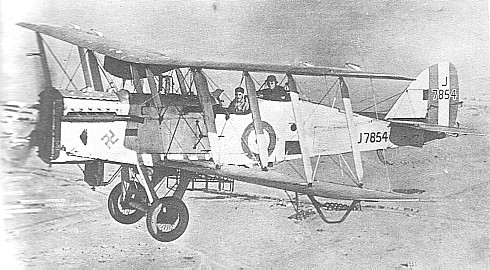 |
The fore runner to the Wapiti, the DH9A (No 4FTS Abu Sueir) |
The facility of the Wapiti to absorb DH 9A spares carried the day as large stocks of DH 9A components were held at RAF stations, particularly overseas. Robert Bruce who had been associated with Admiralty aircraft design and who had joined Westland in its early years, together with Arthur Davenport, Chief draughtsman and later Chief designer , designed the Wapiti around the DH 9A and the Westland Walrus (a machine of greater span than the Nine-Ack and designed as a fleet spotter). Thus the Wapiti was in effect a “third re-design” of the DH 9A, itself a development of the DH 4. The prototype Wapiti J8495 had wings, tail surfaces, ailerons and inter-plane struts which were all DH 9A components. The fuselage entailed considerable re-design to meet service requirements and was a little wider and a foot deeper than that of the DH 9A. The undercarriage was a completely new design for the Wapiti. The first flight undertaken by Major LP Openshaw demonstrated a near total lack of directional control with the rudder. This was later traced to an omission in construction of a foot and half of a fuselage bay (as compared to the wind tunnel model) thereby reducing the tail volume of the rudder and its lever arm. As the drawings were completed, no change was made to the first 25 aircraft already planned, and the rudder and fin of the aircraft was to grow continuously in subsequent batches until from the original ‘Nine Ack’ configuration emerged the large tail so characteristic of later Wapitis.
 |
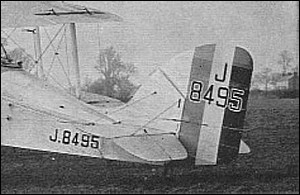 |
| The prototype Wapiti J8495 seen with the original tail (Above) and with later modified definitive Wapiti tail (Right) |
A fourth redesign was undertaken in the Wapiti Mk V finally restoring the correct tail moment arm by incorporating the missing fuselage bay and thus increasing the over all length. Handley-Page slots were fitted on the Mk IA onwards as standard and the Wapiti was in fact the first production airplane so equipped. The Mks II and IIA were the types that were characterized by an all metal square section metal tube frame.
Flight controls: The general layout of the DH 9A controls was followed, with small changes in the rudder control system and full dual control was fitted. The pilot had a spade control grip and the gunner had a detachable control stick that could be attached to the cockpit floor with clips. The rudder bar in both cabins operated the rudder as well as the steerable tailskid that was fitted with an easily changeable cast iron shoe. A light spring fitted to the ruder bar supplied the required bias needed to counter the tendency to swing to starboard induced by engine torque and slipstream effects. Communication between the two cockpits was through a speaking tube. Apart from modifications to suite the Frise ailerons and the fitting of leading edge slats to the upper main planes, the wings of the Wapiti I were generally similar to those of the DH 9A. The ailerons were statically balanced about their hinge axes by a load distributed along their leading edges. The tail plane and elevators were standard DH 9A units, which could be set on the ground as well as in the air by the use of an adjusting gear which moved the rear spar and gave movement of up to 70 at the tail plane center. The fin and rudder were considerably altered, both having metal frames and being of greater area.
Armament and Camera installation: A forward firing fixed Vickers Mk II 0.303 air cooled machine gun was mounted on steel brackets on the port side and could be reached in flight by a sliding door on the pilot’s cockpit wall while an ammunition box containing 600 rounds was positioned transversely beneath the pilot’s feet. Sighting was by means of a ring and bead sight on top of the fuselage and a thumb lever on the spade grip fired the gun. The rear occupant’s Lewis Mk III gun fitted with a Norman sight was mounted on a No 7 Scarff ring. Six 97 round magazines were provided, three on either side of the cockpit and on the right side was a metal holster for a Very signal pistol and a rack for eight cartridges. A hole in the bottom of the observer/gunner station accommodated the course-setting bombsight Mk II G and allowed an outlook from the prone position. The aperture, which had an adjustable windscreen, could be covered by a sliding door operated by a hand wheel on the port side of the floor. Above this was a sliding door used by the occupant when standing. An air speed indicator and an altimeter were fitted on either side of the floor where they could be read in the prone position. Bombs up to 590 lbs could be carried in several combinations of 20lb HE, 112 lb HE, 230 lb HE and 250 lb HE caliber.
For photographic duties, a P7 type A aerial camera was mounted vertically in bay No 17 and could be operated by a prone observer. Wireless equipment was housed in the top decking immediately behind the observer’s position and was driven by a retractable 1,200V windmill-driven generator.
A camera gun could be fitted under the port lower main plane and there was provision for “desert equipment” comprising a wooden crate to carry tins containing 8 gal of water, a fitter’s tool box, ration boxes, a spare wheel, an engine toolkit roll, screw pickets, a foot pump, a jack, a petrol funnel with a chamois leather filter and up to 50lbs of personnel equipment.
Powerplant: The Wapiti came with three different power plants depending on the mark. These were the 460hp Bristol Jupiter VIII, F, IX, F direct drive or 486/512hp Armstrong Siddeley Jaguar S or 527/570hp Panther II geared, partially or fully supercharged engine. The Indian Mk IIAs were powered by the Jupiter VIII nine cylinder air cooled radial coupled to the direct drive Fairy Reed two bladed wooden or metal propeller.
Wapiti Production:
| Type | Serial Number Range | Total Produced |
| Prototype | J 8495 | 1 |
| Mark I | J 9078-J 9102 | 25 |
| Mark II | J 9237-J 9746 | 10 |
| Mark IIA | J 9247 (Prototype) J 9380 – J 9414 J 9481 – J 9514 J 9592 – J 9636 J 9708 – J 9724 J 9835 – J 9871 K 1122 – K 1157 K 1254 – K 1309 K 1316 – K 1415 K 2252 – K 2320 |
1 35 34 45 17 37 36 56 100 69 |
| Mark V | J 9725 – J 9759 | 35 |
| T Mark VI | K 2236 – K 2251 | 16 |
| Grand Total | 517 | |
Individual serials and conversions:
| Type | Serial Numbers |
| Floatplane | J 9084, J 9497 and J 9498 |
| Dual Control | J 9082 and J 9083 |
| Composite wood/metal structure: | J 9380 – J 9414 |
| Wallace Conversion: | J 9605 and J 9864, K 3676, K 2306 – K 2320 |
| Overseas duties in India: | J 9481 – J 9514 K 4337 – K 4348 K 5071 – K 5073 K 2289 – K 2305 K 1254 – K 1309 was for Army Co-op in India |
Wapiti in Service: In service with the RAF and other air forces, the Wapiti faithfully followed the pattern pioneered by its famous forebear, the “Nine-Ack” and earned as undying a tradition, very largely as an Empire policeman. There was no operational duty beyond it and whether over the desert wastes of Iraq, in the unforgiving mountains of India’s north west frontier or the 6000 Km of the Indian and Burmese coast line, the burning sands of Arabia, over the outback of Australia or the bush veld of South Africa, The Wapiti served with distinction as an all purpose war plane and transport, looking like the proverbial Christmas tree thus following the DH9A tradition (four improved Mk VIIIs also served with the Central Chinese Govt in 1931). Many variants of the Wapiti and its development, the Wallace were produced (total 565 numbers). There was for example the Army co-op version, a sea plane version with floats by Short Bros of Rochester, an Arctic Wapiti with skis, a long range version for desert ops, a target towing version and a two–seater. Wapiti K1142 was even used for early in-flight refueling trials with Vickers Virginias.
The first RAF Squadron to receive the Wapiti was No 84 at Shaibah in Iraq and the RAF units to operate the Wapiti in India were Nos 5,11,20,27,28,31 and 60 squadrons. During the historic evacuation of civilians from Kabul at the end of 1929, a Wapiti made the first flight from Peshawar to Kabul through the hazardous Khyber Pass, while Wapitis of No 20 Squadron RAF escorted Vickers Victorias in the same operation. In Jan 33 four Wapitis of No 28 Squadron RAF flew 6200 miles from Ambala to Singapore and back.
In Indian service the Wapiti followed the RAF squadrons at the frontier rotating through all the forward airfields of Peshawar, Quetta, Risalpur, Fort Sandeman, Miranshah, Kohat, Chaklala, Ambala and the forward strips of Drazinda and Manzai. Main activity was against the Waziris and Bhittani tribes in the Mami Ragha and Lwargi Narai areas north of Razmak. A ‘B’ flight was added in 1938 and then a “C” flight, all these finally came together in Jul 1938 with three aircraft per flight. By Jun 39 No 1 Squadron relinquished its Wapitis for Harts (India). With the outbreak of war in Europe, an expansion was planned around five Coastal Defence Flights (CDF) manned by the newly raised Volunteer Reserve Flights (IAFVR). Training began for mostly Indians and a few British businessmen who held pilots licenses, at Risalpur (27 Squadron RAF being converted to a flying training school). All the units except 2 CDF were equipped with Wapiti IIAs and Vs. In the mean time owing to lack of aircraft and spares, two flights of No 1 Squadron went back to the Wapiti and deployed once again on the frontier in support of the Razmak and Bannu Brigades engaged in operations in the Tochi valley.
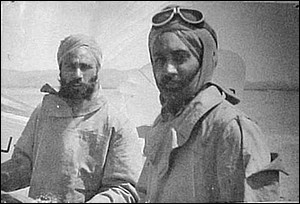 |
Two weather beaten air crew of ‘A’ Flight, IAF pose by their Wapiti IIA at Fort Sandeman, circa 1934 |
| A line up of Six Wapiti IIs and one lone Hawker Audax (2nd from left) from an undated photograph. | 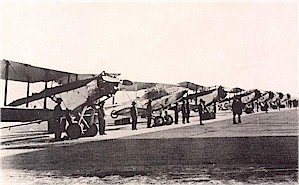 |
Meanwhile the Wapiti was thrown into a role that it was never designed for- long range coastal patrol. Yet the flights flew in all weather, up and down India’s 6000 Km coastline, one aircraft (J9742, 28 Mar 42) running out of fuel and ditching in the sea while shadowing a Japanese Submarine (five Japanese submarines were operating between Sumatra and Ceylon by Apr 42) . It was a Wapiti of No 6 Vizagapatanam CDF (raised Mar 42) that first sighted the Japanese fleet which later struck Trincomalee and Colombo. One Wapiti attempted an inconclusive attack on a Japanese submarine but could not catch up before the craft submerged. No 4 CDF moved to Moulmein from Karachi in Dec 41 during the early stages of the Burma debacle. Losing four aircraft on the ground to Japanese bombers the remainder continued to patrol up and down the Tenaisserrine coast until evacuated to Dum Dum, Calcutta. By the end of 1942 all most all the CDFs were amalgamated into new raisings as the IAF rapidly expanded to a nine Squadron force (No 1 to No 10 sqn, No 5 not being raised to avoid confusion with No 5 Squadron RAF). The remaining wapitis moved to Anti Aircraft Artillery Co operation roles and as training airframes for apprentices.
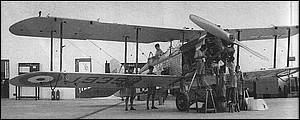 |
IAF airmen undergo training on a Mk IIA J9393 at No 1(Indian) SFTS Ambala. This machine was handed over by No 11 Squadron RAF when it converted to Harts in 1932 at Risalpur. |
No clear date is available on the last flight of the Wapiti in IAF service and like all good soldiers, the Wapiti also, just faded away. While no direct information is available on the ID of the early Wapitis that formed the basis of the IAF, K 1260, 1263, 1290, 1297, 2653, J 9393, 9483, 9742 and 9755 certainly flew with No 1 Squadron in the early days. Of the Wapiti’s that served with the CDF’s the following information is available:
|
Serial |
Unit |
Remarks |
| J9499 | 6 CDF | |
| J9742 | 4 CDF | Ditched 28 Mar 42 |
| J9754 | 2 CDF | |
| K1254 | V, 5 CDF | lost at sea 9 Jun 42 |
| K1260 | 5 CDF | force landed Bhuj 4 Oct 41 |
| K1261 | 5CDF | SOC 6 Apr 42 |
| K1263 | Y CDF | |
| K1269 | 4CDF | crashed Drigh Rd 30 Oct 41 |
| K1270 | 3 CDF | SOC 6 Apr 42 |
| K1271 | V CDF | |
| K1273 | Q. 5 CDF | |
| K1275 | 2 CDF | SOC 17 Jul 42 |
| K1276 | 4 CDF | Crashed Dum Dum 16 Mar 42 |
| K1286 | Q CDF | 16 Mar 42 |
| K1290 | 5 CDF | Plt Offr Sequira/Nasiruddin dived into sea off Cochin, 25 Jul 42 |
| K1291 | Q, 5 CDF | |
| K1298 | 6 CDF | |
| K1308 | 5 CDF | Plt Offr Aurora/Sandhu ditched off Cochin, 20 Feb 42, rescued. |
| K1394 | V, 2 CDF | SOC, 16 Jun 42. |
| K1403 | V, 2 CDF | |
| K2276 | 4 CDF | crashed Drigh Rd 7 Nov 41 |
| K2277 | 4 CDF | Forced landing Kalpi (Gwalior) 25 Mar 42 |
| K2289 | 5 CDF | |
| K2290 | 2,5 CDF | Crashed at Bangalore, 15 Jul 42 |
| K2294 | 5, 6 CDF | crashed at Drigh Rd, 21 Oct 40, repaired |
| K2303 | 3,4 CDF | |
| K2304 | 2 CDF | Plt Offr Russell/Johnson crashed Juhu 27 Nov 40. |
Wapiti markings: All Wapitis in RAF service were doped overall in silver and standard roundels with black serials underwing and on the fuselage and later-on the fin.
All Wapitis had their anti glare upper decking in dark green except for No 5 Squadron that which was in red and 27 Squadron which was in emerald green. All India based aircraft had Squadron ID bands in various colours from Black to red on the fuselage. There is no evidence to indicate that the IAF’s Wapitis, essentially ex RAF aircraft, would follow any other scheme. However, the Squadron ID markings were changed at least in the case of No 1 sqn. This Squadron chose a chequered square on the fuselage and upper port main plane.The colour of this scheme has been indicated as light Blue and dark Blue by one of the earlier Wapiti Observers of the IAF – Hawai Sepoy Taunque. Many art works of IAF wapitis appear with the upper decking in grey. This is a curious interpretation. RAF Wapitis sported the tail rudder stripes with blue forward till 1930 and then switched to red forward till 1934 when they were totally removed. No 1 Sqn also used its initial sqn codes of ‘NB’ on at least one Wapiti- J9755.
Flying the Wapiti:
AVM Harjinder Singh (first “Hawai Sepoy and founder member of the IAF) remembers that the wireless set was particularly primitive and he recalls changing the valves from the rear cockpit, in flight, whenever the pilot tapped his ear phones. He remembers swallowing more dust than in the rest of his life when hanging on to the Wapiti’s wing tips as the pilot taxied it. Also the 488 sq ft of main plane fabric required constant washing and scrubbing.
Pilots found the cockpit more draughty than the DH9A but more comfortable owing to the deeper fuselage. However, rear seat occupants enjoyed no such comfort and had to hang on to the coaming whenever the pilot executed a poorly flown loop (the gunner was attached to the floor by a monkey chain and did not enjoy the security of a harness as the pilot did). Pilots found the Wapiti quite stable yet responsive. Although not fully aerobatic (aerobatics were seldom practiced so as not to upset the rigging and the bombsight) she could be looped and stall turned, but as one pilot recalls, even the most modest repertoire was hard on the gunner. Given to few vices in the air, the Wapiti displayed a significant tendency to swing on take off and landing, which, and the fact that there were no wheel brakes, led to ‘expensive’ landings on occasion.
Where did you go to my lovely ??: The lone survivor
Given that the Wapiti was the foundation stone of the IAF , as it were, it is not surprising that the only surviving airframe in the world rests in the IAF museum. Notwithstanding the significant effort undertaken to restore the machine in the early sixties, the aircraft only just resembles a Wapiti.
| K163 – The lone survivor at the Indian Air Force Museum in Palam. [Hans van Herk] |
There is no engine but just a vague look-alike, the undercarriage is bare with vehicle tyres and the national markings are a curious green, white and blue (at last count, no nation claimed these colours) and the serials are totally incorrect. Many Jupiter VIII engines are available with the South African Air Force Museum and enough data is available to credibly restore the only remaining Wapiti in the world. The IAF’s founding warplane sits in the museum today crying out for the respect and grandeur that it deserves.
|
All Photographs from the Authors personal collection. The Coastal Defence Flights – Photo album
This article has appeared in the 2003/VI issue of Vayu Aerospace Review
This article also inspired the book “The Westland Wapiti in the Indian Air Force Service (1933-43)” by P V S Jagan Mohan |
